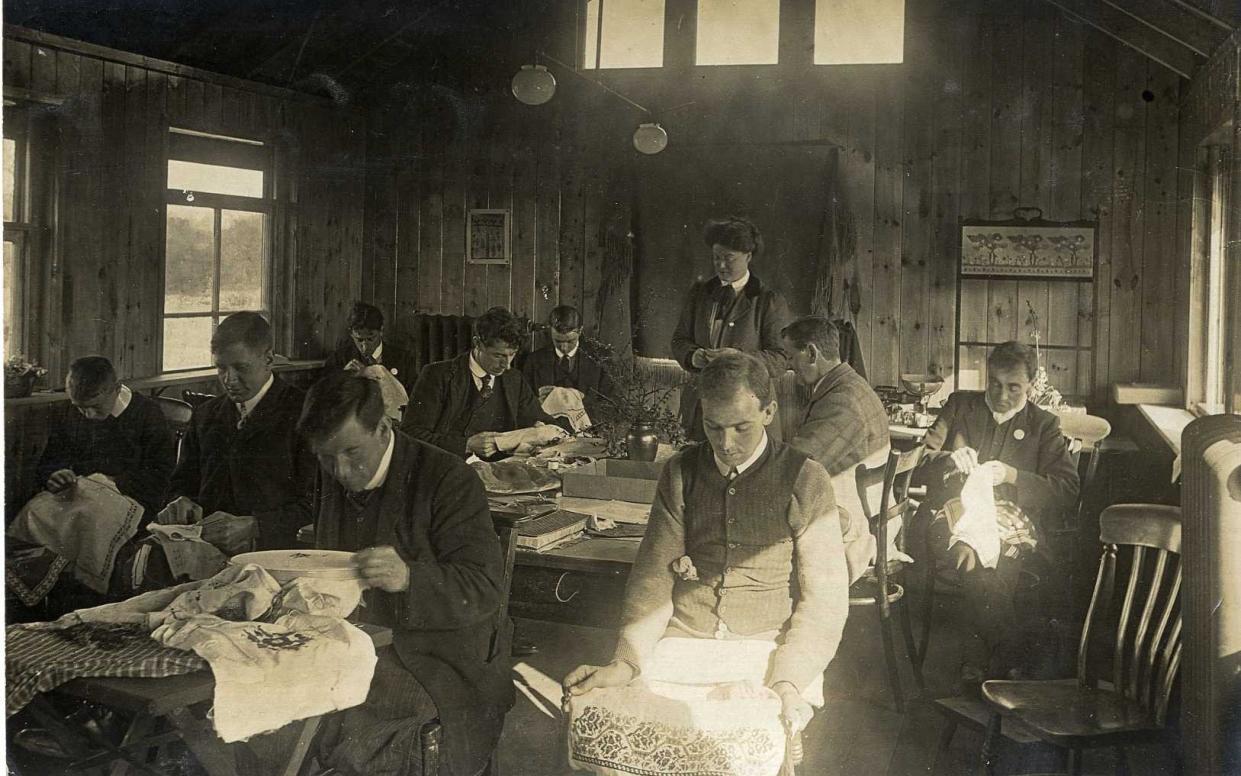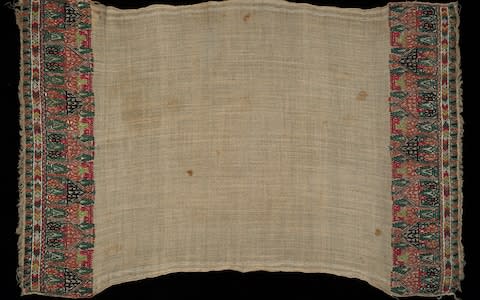Tracy Chevalier on the unsung heroine of British textiles who taught shell-shocked soldiers how to sew

It’s surprising who is hidden beneath the surface of things. Most of us breeze through life barely registering what we see, without asking, “Who designed that house?” “Who crossbred that flower?” “Who created that fabric?” “Who mixed that particular colour of paint?”
When I was visiting Winchester Cathedral a few years ago, among all the masterful stained glass and wood and stone carving, I noted unusually intricate and colourful cushions in the choir stalls. The kneelers had medieval-style rosettes in the centre of mottled blue backgrounds. The cushions were adorned with circular medallions depicting different aspects of Winchester history: kings and queens such as Canute, Matilda and Richard I, as well as events of the English Civil War and even the shipping industry in Southampton.
I didn’t consider who was behind the cushions’ making until I came upon a display about them and the name Louisa Pesel caught my eye. She was the head of the Cathedral Broderers, a group of women formed in 1931 who, over a period of five years, embroidered 98 cushions and more than 300 kneelers for the cathedral. Along with her friend, the artist Sybil Blunt (1880-1952), Pesel designed the cushions and kneelers and organised the 180 volunteers, teaching them the stitches, providing them with models, and ensuring that the project ticked along like a genteel military operation.
As a historical novelist I am always looking for stories, and that of the Winchester cushions and kneelers appealed to me – partly for the setting, partly because I am interested in how our ancestors made things, but mainly because when you look around an important historical building like a cathedral, everything you see has been designed and made by men – except, in this case, the cushions.
I was drawn to Pesel’s curious community, and to Pesel herself. Although I did not make her the main character of my novel A Single Thread, she underpins it, with a steadiness, a clear eye, and an understanding of how and when to do the right thing. She is the book’s moral compass.

I was delighted to find, then, that Pesel is included along with six others in the new exhibition Unbound: Visionary Women Collecting Textiles (at Two Temple Place in London). The show celebrates two centuries of women who have been drawn to textiles for various reasons, whether as something they have made, or as a way in to a particular culture, or as an understanding of the social significance of a piece, or as a medium of creative expression.
Pesel’s interest stemmed from the making side of textiles. Born in 1870 and brought up in a prosperous Bradford family, she embroidered from an early age, and it became her life’s work. She studied drawing, design and “decorative stitching” in London, and taught, lectured and wrote books about the subject throughout her life. She made samplers for the Victoria and Albert Museum to display the stitches used in Old English embroidery. She became president of the Embroiderers’ Guild. As her sister Laura described in an obituary, Louisa Pesel knew its rich history well, and had a “determination to lift the craft of embroidery on to the highest level it had held previously”.
In the early 20th century she taught embroidery for five years at the Royal Hellenic School of Needlework and Lace in Athens – a surprising thing for an unmarried British woman to do then. She also travelled – within Europe, and to India and Egypt.
Everywhere she went she took note of the embroidery of the place.
Back in England, Pesel worked with shell-shocked soldiers during the First World War in Bradford, teaching them to sew “for the soothing value of doing something with the hands”. She was keen to give the soldiers colourful pieces to embroider, explaining that “soft, rich and gracious colours all have an obvious curative effect”. Her work with them was so successful that the scheme was copied in other towns.
Pesel never married or had children, and her twin passions remained embroidery and cultivating irises. Later she moved to Winchester, where some cushions she designed for the Bishop’s private chapel at Wolvesey Palace caught the eye of the cathedral’s dean, who asked her to undertake the massive task of making soft furnishings for the choir stalls.
She was a fair but exacting leader, requiring that broderers first teach their stitches to someone else before they were allowed to make a cushion or kneeler. She made the women unpick their work again and again until it was perfect. Of the work they did, Pesel said: “It is extraordinarily inspiring to feel that you are doing something that should last for generations, possibly several hundreds of years, and that you are permitted to help in a work for all time.” Indeed, the cushions are still being sat upon, the kneelers knelt on, and they are in good nick.
The Unbound exhibition explores our curious compulsion to collect. People amass specific things for various reasons. Perhaps they feel a special affinity for an era. Or they want to learn more about a specific place or person or technique. Or they want to surround themselves with beauty. Or they want to bring order into a chaotic world, to catalogue and preserve something they fear might otherwise be lost.
Why did these seven women collect textiles? Textiles are ubiquitous in our lives, intimately so. The clothes we wear, the sheets and covers on our beds, the cushions we sit on, the napkins and placemats and tablecloths we use at meals. Our coats, hats, scarves. The bags we carry things in. Curtains, carpets, wall hangings. We are surrounded by textiles – they touch us all day and all night. Most of us ignore them, though much attention has often gone into their making.
I, too, ignored textiles until I wrote The Lady and the Unicorn, a novel about medieval tapestries. Then textiles began to creep into my work: quilting in The Last Runaway, and now embroidery in A Single Thread.
Louisa Pesel collected embroidered textiles wherever she went, particularly from the eastern Mediterranean. She did so primarily in order to study techniques. Many of the pieces she gathered – now in the Pesel archive in the International Textile Collection at Leeds University Library – are actually fragments of work that she could easily study. Some were gathered, she wrote, “from scraps of material found on the old rubbish heaps of Cairo”. Some of the surprising colour combinations in the Winchester cushions – blue with mustard yellow, green with pinkish red – can be traced to these fragments gathered from elsewhere. To me the cushions have a pleasing exotic element – a blending of English and continental traditions that reminds us aesthetics are rarely purely from one country or another, but display a migration of influences.
Pesel was also keen to preserve techniques through teaching the old ways – to Greek schoolgirls as well as Bradford soldiers and Winchester women. Her work for the V&A and her books such as English Embroidery, which details stitches from 17th-century samplers, are further proof of her desire not to let textile history die. She and the other women in Unbound have saved a treasure trove of fascinating work that will encourage us to keep that interest alive.
Unbound is at Two Temple Place, London until April 19. Details: twotempleplace.org. A Single Thread by Tracy Chevalier is published by The Borough Press

